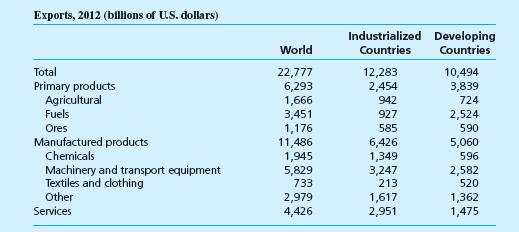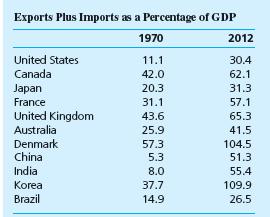To understand stories about how trade works, it is useful to know some of the key facts
Question:
To understand stories about how trade works, it is useful to know some of the key facts about trade. A good start is a broad overview of the products traded and trade’s growing importance.
How large is international trade? What products are traded? The table below shows exports by major product categories, for the world overall and for two broad economic groups of countries, the industrialized (or developed or advanced)
countries and the developing countries.
In 2012, world trade was nearly $23 trillion, with the industrialized countries contributing a little over half of world exports. Most goods are traded across national borders, as are many services, including transportation, computer and information services, as well as insurance, consulting, and educational services. For the world, about half of trade is in manufactured products, with the rest of trade split between primary products and services. By comparing the details across the columns, we can see that the broad pattern of exporting by the industrialized countries has some differences from the pattern for developing countries. Industrialized countries export relatively less of primary products, especially fuels. In manufactured products, industrialized countries export relatively more of chemicals, while developing countries export relatively more of textiles and clothing. Industrialized countries are relatively strong in exporting services. We will use this kind of observation—looking at trade across product categories—as we examine why countries trade with each other.
How important is international trade in the economies of various countries? The second table in this box examines one measure of the importance of trade to a country, the ratio of the sum of a country’s total trade (exports plus imports)
to the country’s gross domestic product (GDP, a standard way of measuring the size of a country’s economy). These measures are not completely comparable (exports and imports measure full sales values, while GDP measures value added).
Still, they provide a reasonable way of comparing the importance of trade across time and across countries.
Here are a few observations about what we see in this table. First, for each of the countries


shown in the table (and for most other countries), international trade has become more important. Trade’s increasing importance is one part of the process of globalization—in which rising international transactions increasingly link together what had been relatively separate national economies. Second, trade tends to be more important for countries with smaller economies (such as Canada and Denmark) and somewhat less important for very large economies (such as the United States and Japan). Third, both China and India have gone from being mostly closed to trade to much more open and involved. The experiences of China and India in the past several decades are rather close to the approach we will take in Chapters 2–7—imagining a national economy with no trade and then drawing out what will happen when the country opens up to free trade.
DISCUSSION QUESTION Given the trends shown here, do you think that international trade should have become more controversial or less controversial than it was several decades ago?
Step by Step Answer:






